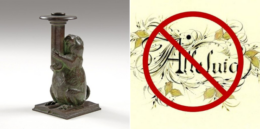Today was a busy day in terms of liturgical music.
The season of Christmastide ended earlier in the week on February 2nd with the feast of the Purification. This feast occurs precisely 40 days after Christmas because, according to the Mosaic Law, a woman was required to go to the temple to be purified 40 days after the birth of a son (80 for a daughter).
This was also the feast of the Presentation of the Child Jesus in the Temple, Candlemas, and Groundhog Day.
Wait! Groundhog Day? Yes, indeed. And it is not a coincidence. Candle processions on February 2nd were customary in ancient Rome to mark the midpoint between the solstice and the equinox. These were effectively Christianized and associated with the Christian holy day of the Purification and Presentation.
Meanwhile, a folk custom developed throughout Europe of predicting the weather on Candlemas. Generally, if Candlemas were sunny, that would presage a longer winter. The German lore would observe the following.
Sonnt sich der Dachs in der Lichtmeßwoche, so geht er auf vier Wochen wieder zu Loche.
If the badger sunbathes during Candlemas-week, for four more weeks he will be back in his hole.
German immigrants brought the custom into Pennsylvania, though they adopted the indigenous groundhog in place of the badger.
Similar proverbs exist in all European countries and many other countries throughout the world. This is one of several variations from England:
If Candlemas be fair and bright, Come winter, have another flight. If Candlemas bring clouds and rain, Go winter, and come not again.
Every Italian village and town seems to have its own version. One that is common in Rome:
Per la santa Candelora se nevica o se plora dell’inverno semo fora.
For the feast of Candlemas, if it snows or rains, we’re done with winter.
The joyful seasons of Christmas and Epiphany being behind us, we will soon enter the penitential season of Lent. The 3-week season of Septuagesima bridges the gap between the Christmas season and Lent. We now leave behind the joyful Gloria, and the joyful word, Alleluia. The Gloria will be sung on Holy Thursday, and feast days, but the Alleluia will be strictly avoided until the Mass of the Paschal Vigil. So, of course, we will refrain from singing hymns that contain the word Alleluia.
Recall our rule of thumb that if the priest is wearing green, we will often sing Mass XI. There is another rule of thumb: If the priest is wearing purple, we will usually sing Mass XVII. But it would be premature to sing Mass XVII during Septuagesima because Mass XVII is to be used for Lent and Advent. The book that gives us much guidance regarding the Liturgy, the Liber Usualis, doesn’t give us an option for the commons, prescribing Mass XI. So, we have the interesting case where the priest is wearing purple, but we sing Mass XI – and of course, we sing it without its Gloria. And as usual, we paired it with Credo I.
The hymns we choose during Septuagesima will generally have a penitential character, but we still have much to celebrate. So, as the processional we sang Immaculate Mary (with the Lourdes refrain) in honor of Our Lady of Lourdes, which feast will be celebrated later this week.
At the Offertory, we sang Parce Domine, omitting the fourth verse owing to the specific reference to the fasting of Lent.
At the Communion, the mixed choir sang the very penitential De Profundis.
We concluded the Mass with God of Mercy and Compassion,which has a certain penitential feel to it without being full-on Lenten.
Father blessed throats after Mass as the feast of Saint Blaise had come earlier in the week. The Schola sang the Sequence from the feast of Our Lady of Sorrows, the very Lenten Stabat Mater.
